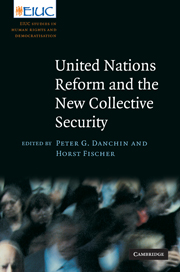Book contents
- Frontmatter
- Contents
- List of contributors
- Series editors' preface
- Preface
- List of abbreviations
- Introduction: the new collective security
- PART I Law and politics in United Nations reform
- PART II Defining “threats” to collective security
- 4 Assessing the High-Level Panel Report: rethinking the causes and consequences of threats to collective security
- 5 Collective security and the responsibility to protect
- 6 Responses to nonmilitary threats: environment, disease, and technology
- PART III Prevention and responses
- PART IV Perspectives on the ground
- Bibliography
- Index
6 - Responses to nonmilitary threats: environment, disease, and technology
from PART II - Defining “threats” to collective security
Published online by Cambridge University Press: 05 May 2010
- Frontmatter
- Contents
- List of contributors
- Series editors' preface
- Preface
- List of abbreviations
- Introduction: the new collective security
- PART I Law and politics in United Nations reform
- PART II Defining “threats” to collective security
- 4 Assessing the High-Level Panel Report: rethinking the causes and consequences of threats to collective security
- 5 Collective security and the responsibility to protect
- 6 Responses to nonmilitary threats: environment, disease, and technology
- PART III Prevention and responses
- PART IV Perspectives on the ground
- Bibliography
- Index
Summary
The dilemma: abstract concepts without a new paradigm
The UN Charter outlines the UN Security Council's primary role as the “Commander in Chief” of the UN and grants the Security Council special power to address military threats to global security. However, for the first time in the history of the UN, there are proposals to reform the Security Council and make it capable of responding to nonmilitary threats to global security. There are two primary reasons for this reform. First, heightened awareness in the international community of increasing environmental degradation, diseases that spread globally, and extreme risks caused by weapons technology created pressure to have these phenomena considered threats to global security requiring the attention and swift action of the Security Council. Second, at the forefront for all actors participating in the reform process (states, representatives of states, UN organs and expert panels within and outside the United Nations) stood the profound change in global relations since the end of the Cold War. The common perception accepted by these actors was that the old, military threats of the Cold War had been replaced by new, nonmilitary threats to global security. The threats posed by environmental degradation, disease, weapons technology, and biotechnology became the new, twenty-first-century enemies of global security and the UN needed to be better equipped to address them.
Although general opinion accepts that these trends clearly pose threats to international security, the way in which the global community should respond to these threats lacks equivalent clarity.
- Type
- Chapter
- Information
- United Nations Reform and the New Collective Security , pp. 173 - 192Publisher: Cambridge University PressPrint publication year: 2010



